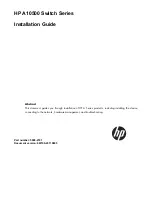
Using iLO 2 121
differently for each p-state the processor was in, with each colored portion scaled to represent the
percentage of the total time the processor spent in that p-state. Pausing the mouse over the bar graph
displays a tool tip that indicates the numeric percentage that portion of the bar represents.
Power efficiency
iLO 2 enables you to implement improved power usage using a High Efficiency Mode (HEM). HEM
improves the power efficiency of the system by placing the secondary power supplies into step-down
mode. When the secondary supplies are in step-down mode, the primary supplies provide all the DC
power to the system. The power supplies are more efficient (more DC output Watts for each Watt of AC
input) at higher power output levels, and the overall power efficiency improves.
When the system begins to draw more than 70% capacity of the maximum power output of the primary
supplies, the secondary supplies return to normal operation (out of step-down mode). When the power
use drops below 60% capacity of the primary supplies, the secondary supplies return to step-down mode.
HEM enables you to achieve power consumption equal to the maximum power output of the primary and
the secondary supplies, while maintaining improved efficiency at lower power usage levels.
HEM does not affect power redundancy. If the primary supplies fail, then the secondary supplies
immediately begin supplying DC power to the system, preventing any downtime.
You can configure HEM only through the RBSU. You cannot modify these settings through iLO. Settings for
HEM are Enabled or Disabled (also called Balanced Mode), and Odd or Even supplies as primary. These
settings are visible in the High Efficiency Mode & Standby Power Save Mode section of the System
Information>Power tab. This section displays the following information:
•
If HEM is enabled or disabled
•
Which power supplies are primary (if HEM is enabled)
•
Which power supplies do not support HEM



































